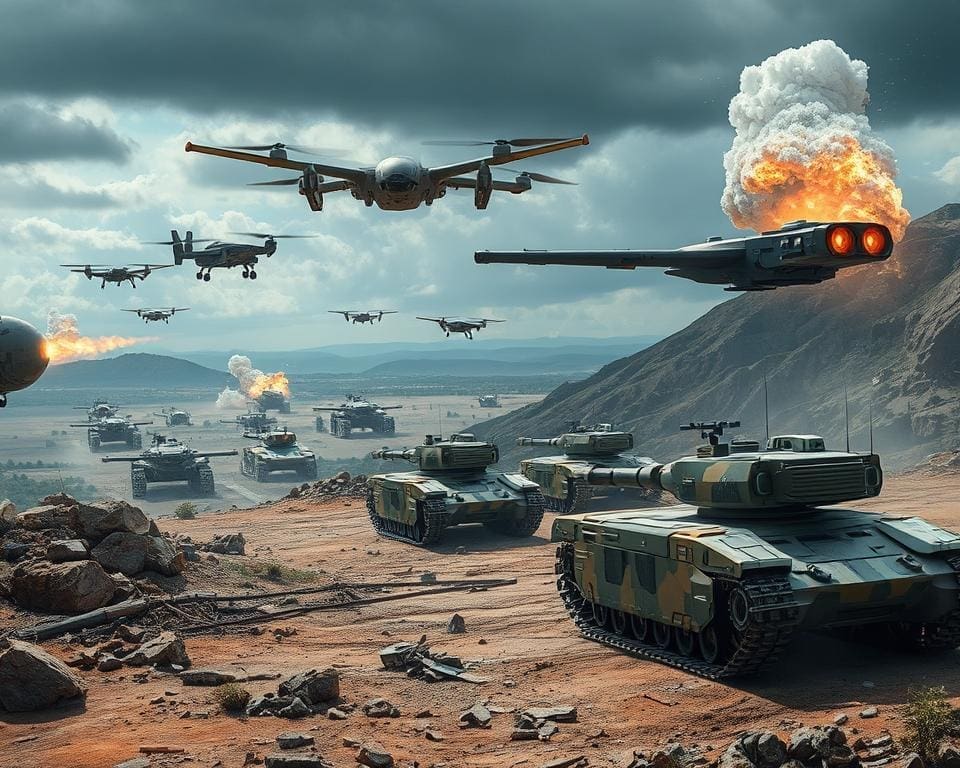The evolution of Autonomous Military Technology represents a significant turning point in modern defence strategies. As military robotics gain traction, the landscape of warfare is shifting dramatically. Major military powers across the globe are investing heavily in this advanced technology, recognising the need for unmanned vehicles that enhance operational capabilities. Current industry reports suggest that by 2030, the market for military robotics could soar to several billion pounds, reflecting a paradigm where The Rise of Autonomous Military Vehicles is not merely futuristic but a necessity. This transformative journey is characterised by sophisticated AI integration, fundamentally redefining how military operations are conducted.
Introduction to Autonomous Military Vehicles
The landscape of warfare is undergoing a remarkable transformation driven by the advent of Autonomous Military Vehicles. These innovative machines are not merely a technological novelty; they represent a fundamental shift in how military operations are conceived and executed. Unmanned systems now offer capabilities that reshape traditional approaches, providing both strategic advantages and new operational efficiencies.
The Concept Behind Autonomous Military Technology
At the core of Autonomous Military Technology lies the ability of vehicles to operate independently or with minimal human intervention. This technology utilises advanced sensors, data fusion, and sophisticated algorithms to create a reliable system capable of navigating complex environments. By combining these elements, military robotics have the potential to enhance situational awareness and decision-making on the battlefield.
The Evolution of Military Robotics
The journey of Military Robotics began with simple remote-controlled devices during World War II, paving the way for today’s advanced systems. Over the decades, the complexity and capabilities of these machines have evolved significantly. Drones and unmanned ground vehicles are now commonplace in modern warfare. They perform diverse roles, such as reconnaissance and supply missions, fundamentally transforming conventional military operations through the integration of AI, machine learning, and automated control systems.

The Rise of Autonomous Military Vehicles
The landscape of military operations is undergoing a dramatic transformation, driven by innovative strides in Unmanned Military Vehicles. As these systems evolve, they redefine traditional paradigms of warfare and tactical engagement.
Key Developments in Unmanned Military Vehicles
Recent advancements in Unmanned Military Vehicles showcase an array of sophisticated technologies. Among these, the MQ-9 Reaper drone stands out, enabling prolonged surveillance and precision strikes in hostile environments. Autonomous ground systems, designed for logistical support, streamline supply chains, ensuring troops receive essential resources faster and more efficiently. These developments have broadened operational ranges and enhanced mission effectiveness, paving the way for a new era in military strategy.
Impact of AI in Defence Technology
AI in Defence Technology has dramatically reshaped how military forces prepare for and engage in conflict. With advanced algorithms, decision-making processes receive a noteworthy boost, allowing for quicker responses to evolving battlefield scenarios. Situational awareness is elevated through comprehensive data analysis and predictive modelling, enabling military personnel to anticipate enemy movements and devise effective countermeasures. The progression towards fully autonomous systems indicates a future where warfare might not rely heavily on direct human oversight, fundamentally altering engagement tactics and strategies.
Advantages of Self-Driving Military Vehicles
The integration of self-driving military vehicles brings forth a multitude of advantages that enhance operational capacities and the safety of personnel. As military organisations increasingly adopt robotics in military operations, the benefits become clearer and more compelling.
Enhancing Efficiency in Military Operations
Self-driving military vehicles excel in improving efficiency within military operations. These autonomous systems can dramatically reduce response times during critical missions. Their ability to process and analyse data in real-time facilitates better resource allocation, enabling forces to act quickly and effectively. This enhancement often translates to successful mission outcomes.
Reducing Risk to Human Life
The deployment of self-driving vehicles significantly mitigates the risk faced by soldiers. Utilising unmanned systems for dangerous reconnaissance missions or combat scenarios lessens the human cost of warfare. Military forces can engage in operations without putting lives at risk, ensuring that personnel remain safe while still achieving strategic objectives.
Cost-Effectiveness and Logistics Improvement
From a financial perspective, self-driving military vehicles contribute to cost savings over time. With reduced manpower requirements, these systems can lower operational costs. Additionally, autonomous vehicles streamline logistics, optimising supply chains and enhancing battlefield performance. This efficiency not only makes operations more effective but also increases the overall value of military investments.
Challenges and Ethical Considerations
The deployment of Armed Autonomous Systems introduces significant challenges and ethical dilemmas that demand immediate attention and rigorous discussion. Rapid advancements in technology often outpace existing regulatory frameworks, creating a landscape fraught with uncertainty regarding the legal and moral implications of using robotics in military operations.
Regulatory and Legal Issues Surrounding Armed Autonomous Systems
As military organisations explore the capabilities of armed autonomous systems, regulatory bodies face enormous challenges in developing comprehensive guidelines. Many legal frameworks struggle to address the complexities surrounding accountability for actions taken by these systems. Key concerns include:
- Determining responsibility for errors made by autonomous systems.
- Ensuring compliance with international humanitarian laws.
- Assessing the implications for sovereignty and military engagement protocols.
The Morality of Robotics in Military Operations
The moral implications of employing robotics in military operations has sparked intense debate. Critics point out the risks associated with allowing machines to make life and death decisions. Considerations include:
- The potential for autonomous systems to misjudge circumstances, leading to catastrophic outcomes.
- The ethical implications of removing human judgement from critical decisions.
- People’s perceptions of morality in warfare when machines assume control.
The Future of Military Vehicles
The landscape of autonomous military technology is poised for transformative growth as we move into the future. Emerging innovations suggest that military vehicles will become increasingly sophisticated in their ability to operate autonomously, utilising advanced AI and machine learning algorithms. This evolution will facilitate enhanced coordination among unmanned systems, allowing for a more integrated approach within traditional military frameworks.
As the reliance on autonomous military vehicles increases, the integration of technologies such as blockchain for securing supply chains and quantum computing for data processing will become pivotal. This fusion of capabilities is expected to not only enhance operational efficiency but also bolster the overall strategic advantage of military forces facing complex global challenges. Defence analysts predict that these advancements will redefine engagement protocols and operational strategies.
Looking ahead, the future of military vehicles signals a shift towards fully autonomous platforms that can efficiently address battlefield demands. As technology continues to evolve, military organisations must adapt to incorporate these innovative systems, ensuring that they remain competitive and resilient in a rapidly changing defence landscape. The potential for autonomous military technology is vast, and embracing it wisely will be crucial for maintaining effectiveness in future armed conflicts.









